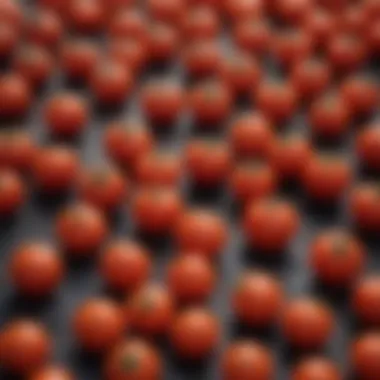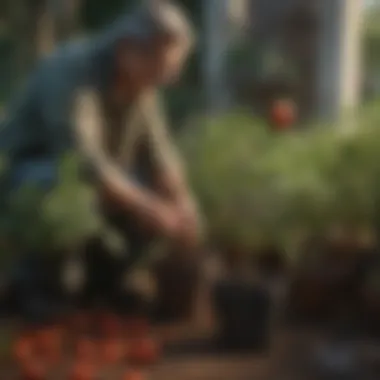Expert Tips for Fertilizing Tomatoes in Pots


Intro
Growing tomatoes in pots offers a practical solution for gardeners limited by space or soil quality. However, to achieve optimal growth and a fruitful yield, understanding how to effectively fertilize these potted plants is vital. This guide unpacks the necessary steps for fertilizing tomatoes, focusing on their specific nutrient needs and how to apply fertilizers correctly.
The first step in ensuring healthy tomato plants is to recognize their nutrient requirements. Tomatoes thrive on a balanced mixture of nitrogen, phosphorus, and potassium. Understanding these essential macronutrients lays the groundwork for selecting the right fertilizer.
In the following sections, we will explore various types of fertilizers available, application methods suitable for potted tomatoes, and some common pitfalls to watch out for. Whether you are a novice gardener just starting out or an experienced grower seeking to enhance your technique, this guide will provide you with practical insights to elevate your gardening practices.
Key Insights and Trends
The container gardening trend has surged in popularity in recent years. This trend reflects a shift towards urban gardening, where space constraints push homeowners to seek innovative solutions. Many gardeners are opting for self-watering pots and biodegradable containers that are both environmentally friendly and efficient.
Current trends in fertilizing techniques
Many gardeners now prefer organic fertilizers over synthetic ones, citing environmental concerns and health reasons. Organic options such as compost, worm castings, and fish emulsion provide essential nutrients while also improving the soil's overall health.
This shift aligns with the growing interest in sustainable gardening practices. Homeowners are increasingly looking for ways to garden without harming natural ecosystems.
Practical Tips and How-To Guides
Step-by-step guides for fertilization
- Assess Soil Quality: Before applying any fertilizer, check your potting mix. It should be light, well-draining, and rich in organic matter. A good mix ensures roots have space to grow.
- Choose the Right Fertilizer: Select a balanced fertilizer like a 5-10-10 formulation for tomatoes. This ratio provides the needed nitrogen for growth and boosts flowering and fruiting.
- Application Methods:
- Monitor Plant Health: Watch for signs of nutrient deficiency, such as yellowing leaves or stunted growth. Adjust your fertilization schedule as needed.
- Granular Fertilizer: Mix it into the top inch of soil. Water thoroughly after application.
- Liquid Fertilizer: Dilute according to package instructions and apply every two weeks during the growing season.
- Slow-Release Granules: Great for long-term fertilization. Apply at the beginning of the growing season and allow it to dissolve slowly with watering.
Proper fertilization is crucial in cultivating robust tomato plants, ensuring they are both healthy and productive.
Common mistakes to avoid
- Over-fertilization can lead to excessive foliage growth at the expense of fruit production. Always follow recommended dosages.
- Skipping soil tests can result in an imbalance of nutrients, leading to poor plant health.
- Ignoring water requirements post-fertilization can cause nutrients to leach away or, conversely, become too concentrated.
By adhering to these methods, gardeners can foster healthy tomato plants that yield abundant fruit while making the most of their potted environment.
Intro to Container Gardening
Container gardening has become a practical solution for many gardeners, especially those limited by factors like space and soil quality. Growing tomatoes in pots is a popular choice among both novices and advanced gardeners. This method not only allows cultivation in smaller areas but also provides more control over growth conditions. The container serves as a manageable environment where soil quality, moisture levels, and nutrients can be adjusted easily, which is essential for tomato plants that have specific growth requirements.
Understanding Tomatoes in Pots
Tomatoes are a versatile plant, but their success in pots hinges on understanding their growth habits. When grown in containers, tomatoes can thrive provided that their basic needs are met. This means they require adequate sunlight, water, and nutrition.
Key considerations include:
- Container size: A larger pot can accommodate the root system better, promoting healthier growth.
- Soil choice: A well-draining potting mix is crucial. It should retain moisture but not become waterlogged, which can lead to root rot.
- Sunlight access: Tomatoes prefer full sun and should ideally receive at least six to eight hours of direct sunlight a day.
Benefits of Growing Tomatoes in Containers
Growing tomatoes in containers offers distinct advantages, making it an appealing option for many gardeners. Here are some benefits:
- Accessibility: Container gardening allows for easier planting and harvesting. Elevated pots can be placed at a comfortable height, reducing strain during maintenance tasks.
- Mobility: Containers can be moved to follow the sun or to protect plants from harsh weather. This flexibility can be particularly useful if conditions change unexpectedly.
- Pest control: Potted plants can be isolated from ground pests, reducing the risk of infestations commonly faced by garden beds.
- Soil control: Container gardening allows for a tailored soil mix that meets the specific nutrient needs of tomatoes.
"Container gardening is a practical answer for urban dwellers and those with less gardening experience."
These elements underline the crucial role that container gardening plays, especially when focusing on a popular crop like tomatoes. This approach leads to better management of growing conditions, enhanced plant health, and ultimately, a more fruitful harvest.
Essential Nutrient Requirements for Tomatoes


Understanding the nutrient requirements for tomatoes is vital for growing healthy plants and achieving impressive yields, especially when they are cultivated in pots. Nutrients play a critical role in different stages of the tomato plant's life cycle, from seedling growth to fruiting. Without adequate nutrients, tomato plants may exhibit poor growth, reduced fruit set, or even susceptibility to diseases. It becomes clear that knowing what tomatoes need and how to provide these nutrients can make an important impact on their overall health, which is essential for both novice and experienced gardeners in container gardening.
Primary Nutrients: Nitrogen, Phosphorus, and Potassium
The three primary nutrients essential for tomatoes are nitrogen, phosphorus, and potassium, often referred to as NPK. Each of these nutrients contributes uniquely to the growth of tomato plants:
- Nitrogen is crucial for the growth of leaves and stems. It affects plant vigor and is necessary for protein synthesis. Insufficient nitrogen will stunt growth and lead to yellowing leaves.
- Phosphorus is important for root growth and flowering. It helps with photosynthesis and the energy transfer in plants. A deficiency may result in weak root systems and poor fruit development.
- Potassium supports overall plant function, including water regulation and enzyme activity. It enhances fruit quality and resistance to diseases. A low level of potassium can cause weak plants and a decline in fruit size and quality.
These primary nutrients are often present in different fertilizer blends, and proper understanding of their ratios can help gardeners make informed decisions about fertilization.
Secondary Nutrients: Calcium, Magnesium, and Sulfur
In addition to the primary nutrients, secondary nutrients like calcium, magnesium, and sulfur also play pivotal roles:
- Calcium is essential for cell wall structure and stability. It prevents blossom end rot, a common problem in tomatoes related to calcium deficiency.
- Magnesium aids in chlorophyll production and is integral in photosynthesis. Insufficient magnesium may manifest as interveinal chlorosis, where the leaf veins remain green while the spaces between them turn yellow.
- Sulfur is vital for the production of amino acids and proteins. It is less commonly encountered, but the lack of it can lead to stunted growth and pale leaves.
These nutrients can be accessed through both organic and synthetic fertilizers, and awareness of their roles will enhance a gardener's approach to optimizing tomato growth in pots.
Micronutrients: Iron, Manganese, and Zinc
Micronutrients, while required in smaller amounts, are equally important for tomato health:
- Iron is necessary for chlorophyll synthesis and is involved in various enzymatic processes. Deficiency leads to chlorosis, particularly in young leaves.
- Manganese supports photosynthesis, respiration, and nitrogen absorption. A lack of manganese may affect overall plant vitality.
- Zinc plays a role in hormone production and affects growth regulation. Deficiency results in leaf curling and stunted growth.
Understanding these micronutrients helps in diving deeper into the specifics of fertilization, ensuring that every essential component is considered to promote not only growth but also overall plant vigor.
"A well-rounded knowledge of nutrient requirements substantially enhances the chance for a successful tomato harvest."
So, ensuring that tomatoes in pots receive the right mix of primary, secondary, and micronutrients is key to cultivating a thriving plant worthy of commendation.
Types of Fertilizers Suitable for Potted Tomatoes
Choosing the right fertilizer for potted tomatoes is crucial for their growth and productivity. Fertilizers provide essential nutrients that can be complex for plants to acquire from potting soil alone. The type of fertilizer selected impacts not only the rate of growth but also the flavor and quality of the fruit. For potted tomatoes, there are two main categories: organic and synthetic fertilizers. Each has its advantages and considerations, making it important for gardeners to understand their options.
Organic Fertilizers: Benefits and Options
Organic fertilizers come from natural sources such as plant matter, animal dung, or mineral deposits. They improve soil health as they enhance microbial activity in the potting mix. This leads to better nutrient absorption by the tomato plants.
Benefits of Organic Fertilizers:
- Environmentally Friendly: They contribute to sustainable gardening practices.
- Soil Health: They improve soil structure and increase fertility over time.
- Nutrient Release: Organic fertilizers release nutrients gradually, reducing the risk of over-fertilization.
Options for Organic Fertilizers Include:
- Compost: Rich in nutrients, it is an excellent choice for container gardening.
- Well-Rotted Manure: Provides a broad range of nutrients.
- Fish Emulsion: A liquid fertilizer high in nitrogen, effective for leafy growth.
- Bone Meal: A slow-release source of phosphorus, beneficial for root and flower development.
Consider making a compost tea—a simple solution of compost steeped in water— to enhance nutrient availability and microbial activity in your potted tomatoes.
Synthetic Fertilizers: Overview and Applications
Synthetic fertilizers are made in laboratories and offer a concentrated source of nutrients. They can provide immediate nourishment to tomatoes, but they require careful application and understanding.
Overview of Synthetic Fertilizers:
- Quick Action: Nutrients are readily available for immediate uptake by plants.
- Targeted Nutrition: These fertilizers can be formulated to target specific nutrient needs, making them versatile.
- Precise Dosage: It's easier to measure and apply exact amounts, allowing for tailored fertilization based on specific plant needs.
However, synthetic fertilizers can lead to problems if used incorrectly. Over-application can cause nutrient burn or leach into surrounding soil, affecting other plants. It is essential to follow application guidelines strictly to avoid these issues.
Slow-Release vs. Water-Soluble Fertilizers


The choice between slow-release and water-soluble fertilizers can significantly affect the growth of potted tomatoes. Each has its use cases depending on the gardener's goals and the growing conditions.
Slow-Release Fertilizers:
- Gradual Nutrient Supply: These fertilizers release nutrients over an extended period, which can ensure a steady supply for the plants. They are especially useful for busy gardeners who may forget to fertilize regularly.
- Reduced Risk of Leaching: Since nutrients are released slowly, there is less chance of nutrients washing out of the pot.
Water-Soluble Fertilizers:
- Fast Results: They provide immediate nutrient availability, making them suitable for quick boosts during critical growth periods.
- Flexible Application: These fertilizers can be mixed with water and applied directly to the soil or as a foliar spray.
Considerations:
Choose slow-release fertilizers for long-term growth and convenience during the season. In contrast, opt for water-soluble fertilizers for use during rapid growth phases when tomatoes need a quick nutrient boost.
In the end, the right fertilizer for your potted tomatoes enhances both growth and yield, leading to a healthier and more productive gardening experience.
Application Techniques for Optimal Fertilization
Proper application techniques for fertilizing tomatoes in pots are crucial for their growth and overall health. Effective fertilization enhances nutrient uptake, promotes stronger plants, and maximizes yield. When dealing with container gardening, it’s vital to acknowledge the limitations of pots. Soil in containers tends to dry out and leach nutrients faster than garden soil. Therefore, understanding when to fertilize and the optimal methods for applying fertilizers can make a significant difference.
The following sections will delve into these vital aspects—timing and frequency of fertilization, methods of application, and signs indicating over-fertilization. This insight will help ensure the right nutrients reach your potted tomatoes effectively.
When to Fertilize: Timing and Frequency
Timing and frequency are foundational aspects of effective fertilization. For tomatoes, a good rule is to fertilize every four to six weeks during the growing season. Start fertilizing when the plants are about 6-8 inches tall and have established a solid root system. This usually corresponds to when they are about four weeks old if grown from seed.
Caring for potted tomatoes means taking into consideration visual cues from the plants. If they appear sluggish or have pale leaves, it might be a sign that they require nutrients sooner than expected. Adjusting your schedule according to the plant’s needs can greatly improve their health.
Key points regarding timing:
- Begin fertilizing when plants reach 6-8 inches.
- Use a balanced fertilizer initially, switching to one higher in potassium and phosphorus as flowering begins.
- Monitor plant health regularly to adjust fertilization frequency as necessary.
How to Apply: Methods of Application
The method of applying fertilizer affects its effectiveness. Here are several common methods:
- Granular Application: This method involves broadcasting granular fertilizers on the soil surface. Watering afterward helps to dissolve the granules, allowing nutrients to penetrate the root zone. Granular fertilizers often offer a slow-release feature, making them suitable for a longer growing period.
- Liquid Fertilizer: For immediate uptake, a water-soluble liquid fertilizer is recommended. Mix the fertilizer with water according to package instructions. Apply this mix directly to the soil, avoiding contact with the foliage to prevent burning.
- Top Dressing: This involves adding a layer of organic material like compost on the top of the potting mix. This not only adds nutrients but also improves soil structure and moisture retention.
Considerations for application:
- Avoid applying fertilizers on dry soil; water before and after application.
- Follow the manufacturer’s instructions to prevent nutrient overdose.
- Consider using organic methods to enrich the soil naturally, promoting healthy microbial life.
Signs of Over-Fertilization and Remedies
Understanding the signs of over-fertilization is equally important. Symptoms include:
- Leaf Burn: Tips of the leaves turn brown and crispy. This is a common indicator of too much fertilizer.
- Excessive Leaf Growth: If your tomatoes have lush foliage but few flowers or fruits, they might be getting too much nitrogen.
- Wilting: Over-fertilized plants may wilt, even with adequate watering. This is due to osmotic imbalance in the soil.
If you observe these symptoms, here are some remedies:
- Flush the Soil: Water the plants thoroughly to leach excess salts out of the potting mix.
- Reduce Fertilizer Use: Scale back the frequency and amount of fertilizer applied until the plants recover.
- Assess Plant Health Daily: Regular monitoring will help catch and correct any issues early.
Common Mistakes in Fertilizing Tomatoes in Pots
Fertilizing tomatoes in pots can be a nuanced process, and small mistakes can lead to suboptimal growth. Recognizing and understanding these mistakes is essential for both novice and experienced gardeners. The implications of incorrect fertilization extend beyond mere yield; they affect tomato health, flavor, and overall productivity. This section will explore common pitfalls in fertilization, offering insights on how to avoid them.
Under-fertilization: Identifying Deficiencies
Under-fertilization occurs when tomatoes do not receive adequate nutrients. This can result in stunted growth, yellowing leaves, and poor fruit development. To identify deficiencies, keep an eye for key signs:


- Chlorosis: Yellowing between the veins of older leaves indicates a nitrogen deficiency.
- Slow growth: Limited height and fewer blooms suggest a lack of essential nutrients.
- Poor fruit set: If flowers drop without setting fruit, it might signal inadequate potassium or phosphorus levels.
Properly observing these signs will allow gardeners to make necessary adjustments. Testing soil and monitoring plants regularly can be effective methods to identify and address nutrient needs promptly.
Over-fertilization: How to Avoid Excessive Growth
Over-fertilization is another common issue. While nutrients are essential, too much of them can lead to excessive foliage growth at the expense of fruit production. Symptoms of over-fertilization include:
- Burnt leaf edges: Tips of leaves turning brown and crispy.
- Sparse flowering: Reduced bloom count despite healthy leaves.
- Weak stems: Stems may appear tall and leggy due to rapid but unstable growth.
To avoid these problems, always start with recommended fertilizer amounts. Using slow-release fertilizers can help manage nutrient delivery over time, ensuring that tomatoes receive what they need without the risk of excess. It’s also important to read and follow the manufacturer’s instructions carefully.
Ignoring Soil Quality and Drainage
Soil quality plays a crucial role in the health of potted tomatoes. Ignoring soil composition and drainage can lead to issues that affect plant vitality. Essential points to consider include:
- Soil composition: Use a high-quality potting mix designed for vegetables to provide necessary aeration and fertility.
- Drainage: Ensure pots have drainage holes to prevent waterlogging. Excessive moisture can lead to root rot and other diseases.
- pH levels: Tomatoes thrive in slightly acidic to neutral soils (pH 6.0-7.0). Regularly testing soil pH can help maintain optimal conditions.
Remember: Good soil quality and proper drainage are fundamentally important for successful container gardening.
Focus on these mistakes to foster an environment conducive to the robust growth of tomatoes. Understanding these aspects of fertilization will allow for a more rewarding gardening experience.
Sustainable Practices for Fertilizing Container Tomatoes
Sustainability is a crucial theme in modern gardening practices, especially when it comes to fertilizing container tomatoes. With the growing awareness of environmental issues, gardeners are increasingly seeking methods that not only promote the health of their plants but also protect the planet. Sustainable practices can significantly reduce the need for chemical fertilizers, minimize waste, and lead to healthier soil. When managing tomatoes in pots, sustainable fertilization ensures that you engage in responsible gardening methods, keeping both yield and ecological balance in mind.
Composting: A Valuable Resource
Composting is an age-old practice that transforms organic waste into a rich, nutritious resource for plants. For container tomatoes, compost can provide a slow release of essential nutrients, ensuring that plants receive a balanced diet over time. Benefits of using compost include:
- Improved Soil Structure: Compost enhances the soil, helping with aeration and moisture retention.
- Microbial Activity: It promotes beneficial microorganisms that foster a healthy growing environment.
- Nutrient Availability: It contains a variety of nutrients, making it a multi-faceted addition to your fertilizer routine.
To start composting, gather kitchen scraps like vegetable peels, coffee grounds, and eggshells. Mix these with yard debris like leaves and grass clippings. Be sure to turn the pile regularly to aerate it, which speeds up the decomposition process. After a few months, you'll create a beneficial compost that can enrich your potting soil.
Using Crop Rotation and Companion Planting
Crop rotation and companion planting are both effective strategies that can enhance the sustainability of your tomato fertilization practices. Crop rotation involves changing the location of your tomato plants each growing season. This method helps to prevent soil depletion and reduce pest populations that target specific crops. By alternating what you grow, each type of plant can replenish the soil with different nutrients.
Companion planting complements this approach. Some plants, when grown together, can offer mutual benefits. For example, planting basil alongside tomatoes can repel pests and improve flavor. Additionally, using plants that fix nitrogen, like legumes, can enrich the soil naturally.
Considerations for Companion Planting:
- Pest Control: Use plants that deter harmful insects.
- Nutrient Exchange: Select plants that benefit from each other’s presence.
- Space Utilization: Maximize space to ensure each plant can thrive.
Both crop rotation and companion planting not only support sustainable practices but also enrich the gardening experience, providing an ecosystem that is resilient and productive.
Closure: Enhancing Growth Through Knowledge
Understanding the process of fertilizing tomatoes in pots is crucial for achieving optimal growth and maximizing yield. This guide has examined essential nutrients, the types of fertilizers available, and the techniques for applying them. It has also highlighted common pitfalls that can hinder plant development. Mastering these areas empowers gardeners to make informed decisions, ensuring that their tomato plants thrive in a container setting.
When gardeners are equipped with knowledge about nutrient requirements, they can tailor their approach to suit specific plant needs. For example, knowing the importance of nitrogen for leaf growth versus potassium for fruit development can help in selecting the right fertilizers at the right time. Moreover, familiarizing oneself with the distinctions between organic and synthetic fertilizers allows for a more nuanced application strategy.
The benefits of ongoing learning should not be underestimated. By continuously seeking knowledge, gardeners can adapt their methods based on experience and evolving best practices. This iterative process is foundational for refining fertilization practices, enhancing not just tomato growth but also the overall gardening experience.
Recap of Best Practices for Fertilizing
- Understand Nutrient Needs: Recognize the specific nutrient requirements of tomato plants, which include primary, secondary, and micronutrients.
- Choose the Right Fertilizer: Select between organic and synthetic options, understanding their benefits and drawbacks, especially in a container environment.
- Timing is Key: Know when to fertilize. Regular feeding during growth stages is essential, with attention paid to signs of nutrient deficiencies or excess.
- Method of Application: Apply fertilizers either as slow-release options baked into the soil or as water-soluble types during watering sessions, based on individual gardeners' needs and plants' growth stages.
- Avoid Common Mistakes: Stay vigilant for signs of under-fertilization and over-fertilization. Pay attention to soil quality and drainage as vital components that influence the effectiveness of fertilization.
- Embrace Sustainability: Implement sustainable practices such as composting and using companion planting to create a self-sustaining environment for your tomatoes.
Encouragement for Ongoing Experimentation
Gardening is a practice that thrives on experimentation. Fertilizing tomatoes in pots offers ample opportunity to test different fertilization techniques and observe their effects. Whether trying out a new organic fertilizer or adjusting the timing of applications, every effort provides invaluable insights.
Each tomato plant is unique, and what works for one gardener may not necessarily apply to another. Keeping a detailed journal of what is tried and the outcomes can be a beneficial practice. This not only sharpens one's skills but also contributes to a deeper understanding of the plant's responses.
Furthermore, joining gardening communities online, such as those on Reddit or Facebook, can spur new ideas and provide support. Sharing experiences and learning from others can enrich one’s gardening journey and inspire creativity in fertilizing practices.



